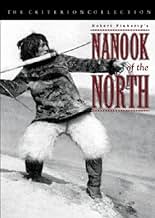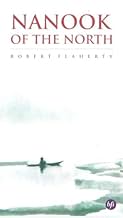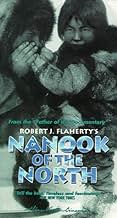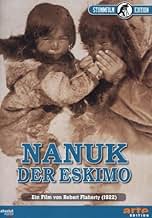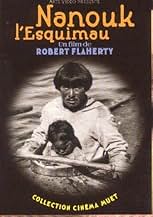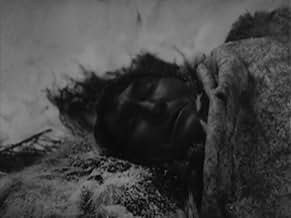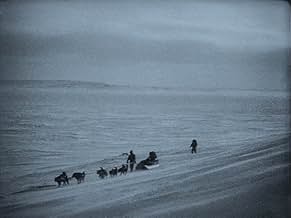IMDb RATING
7.6/10
14K
YOUR RATING
In this silent predecessor to the modern documentary, film-maker Robert J. Flaherty spends one year following the lives of Nanook and his family, Inuits living in the Arctic Circle.In this silent predecessor to the modern documentary, film-maker Robert J. Flaherty spends one year following the lives of Nanook and his family, Inuits living in the Arctic Circle.In this silent predecessor to the modern documentary, film-maker Robert J. Flaherty spends one year following the lives of Nanook and his family, Inuits living in the Arctic Circle.
- Director
- Writers
- Stars
- Awards
- 2 wins total
- Director
- Writers
- All cast & crew
- Production, box office & more at IMDbPro
Featured reviews
Explorer Robert J. Flaherty spent the majority of 1914 and 1915 along the Hudson Bay, doing research and exploring for a Canadian railway company. Being a keen photographer and potential film-maker, he took a camera along with him. He shot 30,000 feet of film, of the native Eskimo tribes and their alien, hunter-gatherer lifestyle. The test footage was met with universal excitement, only Flaherty dropped a cigarette on the highly-flammable nitrate film-stock whilst editing, and lost it all. He would return, only this time with the sole intent on making a narrative- driven documentary, about one specific family of Eskimos, and their highly-charismatic leader Nanook, a legendary hunter.
Though it is now widely heralded as a masterpiece, and the film that gave birth to the documentary genre, the film is often criticised for its obviously staged dramatic scenes, and truth-manipulation in the search for a coherent narrative and to inject the film with an air of excitement and wonder. Personally, I have no problem with this approach, after all, one of my favourite directors Werner Herzog frequently does this in his documentary films to create a sort of artistic truth, opposed to the point-the-camera approach of cinema verite. In the modern age, we are treated to high-definition, sweeping footage of some of the most exotic and hostile corners of the planet, so it's a marvel to see where it all started, and Flaherty, faced with early, clunky film equipment and relatively little experience of film-making, created a magical documentary for an audience that, back then, knew little about the world outside their own country.
Amongst the many set-pieces we are treated to, the greatest (and much- celebrated) is the building of the igloo. We watch Nanook build it with skilled precision, slab by slab, and even incorporate a window feature, in order to give the igloo some warmth, and a chunk of ice by the side of it to divert the sun's rays. With many Eskimos now adopting Western aspects into their livelihood, the film is definitely a window into the past (the Eskimos had in fact already done this, and even wore Western clothes, but Flaherty persuaded them to revert back in order to give the film more of a sense of wonder). For a film-maker who had only taken a three-week course in cinematography prior to Nanook, the film is rich with beautiful imagery. The scene that watches the family trudge into the distance as the mist blows over the snowy surface like fleeing ghosts, gives the film a gorgeous, eerie quality. If you can forgive the film's manipulations, then this is still one of the greatest documentaries features ever produced, and Nanook (real name Allakariallak) proves to be a charming protagonist.
www.the-wrath-of-blog.blogspot.com
Though it is now widely heralded as a masterpiece, and the film that gave birth to the documentary genre, the film is often criticised for its obviously staged dramatic scenes, and truth-manipulation in the search for a coherent narrative and to inject the film with an air of excitement and wonder. Personally, I have no problem with this approach, after all, one of my favourite directors Werner Herzog frequently does this in his documentary films to create a sort of artistic truth, opposed to the point-the-camera approach of cinema verite. In the modern age, we are treated to high-definition, sweeping footage of some of the most exotic and hostile corners of the planet, so it's a marvel to see where it all started, and Flaherty, faced with early, clunky film equipment and relatively little experience of film-making, created a magical documentary for an audience that, back then, knew little about the world outside their own country.
Amongst the many set-pieces we are treated to, the greatest (and much- celebrated) is the building of the igloo. We watch Nanook build it with skilled precision, slab by slab, and even incorporate a window feature, in order to give the igloo some warmth, and a chunk of ice by the side of it to divert the sun's rays. With many Eskimos now adopting Western aspects into their livelihood, the film is definitely a window into the past (the Eskimos had in fact already done this, and even wore Western clothes, but Flaherty persuaded them to revert back in order to give the film more of a sense of wonder). For a film-maker who had only taken a three-week course in cinematography prior to Nanook, the film is rich with beautiful imagery. The scene that watches the family trudge into the distance as the mist blows over the snowy surface like fleeing ghosts, gives the film a gorgeous, eerie quality. If you can forgive the film's manipulations, then this is still one of the greatest documentaries features ever produced, and Nanook (real name Allakariallak) proves to be a charming protagonist.
www.the-wrath-of-blog.blogspot.com
As a documentary turning point, Nanook of the North is undoubtedly one of if not the most significant work of the twentieth century. The story of Nanook and his family became the center of attention of the national media and virtually altered the perceptions the world had of film for documentary purposes. Flaherty may be to the documentary world what J.R.R. Tolkien is to the fantasy world. He is the giant of the genre. For its time, Nanook of the North was a masterpiece. Simple and profound, the story of Nanook was unique, and henceforth the foundation upon which the great documentarians of the 20th century created their works. However, through hindsight, the film falters. Most noticeable is the fact that Flaherty composed each of these sequences ahead of time and purposefully altered Nanook's life in order to make it seem harsher. In what is one of the most famous scenes, Nanook laughs at a phonograph and bites into a record as if he does not understand it. However, it was discovered later that not only had Nanook seen phonographs before, but he was a regular visitor to the trading post, owned a snowmobile and a rifle, and had probably seen a record player before. This fact puts into question the strength of this work as a documentary. Flaherty defended himself, claiming that some things need to be altered in order for the message to be seen. However, this is what we in the film world call "fiction". Plenty of fiction is based upon fact, but when you call something a documentary, it is held up to a different standard, one that Flaherty's work, although, good, fails to achieve.
Robert Flaherty is one of the more noted documentarians in the history of film. It is not without some concentration (ironically maybe) to watch his most well-known work, Nanook of North, which is as much documentary as it is almost the very first widely seen "Home movie". There's no narration aside from the several title cards listing the obvious things that Nanook and his family/tribe are doing in the arctic.
Therefore this is much more of a visual kind of documentary, not as outrageous and experimental as those of Dziga Vertov of the same period (using what camera equipment available, shooting seemingly on the fly), but with a distinct view on what life is usually like for these people. We basically see them doing very elementary tasks, more based on living day-to-day in this harsh climate than anything overly dramatized.
That all of the scenes are really 'staged' (and, apparently, it's not even Nanook's real wife) doesn't deter the viewer from what is being shown. It's like a mix of the objective and subjective- objective in the sense that 'this is what it is, the Eskimos hunting for food, raising their children, making their shelter in igloos, and making trips to ensure their survival'. Subjective in that Flaherty's camera is creating a specific view of these people, their faces captured memorably in the scratchy print of the film. In a way it's also like the first, and perhaps more groundbreaking, of the lot of nature documentaries to follow over the years, though to a primitive extreme.
In all, Nanook of the North is meant to above all show the versatility of these people, both the physical nature (i.e. hunting the seal, which is the most exciting in the film) and the nature of the spirit of these people, living this way as a cycle over and over again.
Therefore this is much more of a visual kind of documentary, not as outrageous and experimental as those of Dziga Vertov of the same period (using what camera equipment available, shooting seemingly on the fly), but with a distinct view on what life is usually like for these people. We basically see them doing very elementary tasks, more based on living day-to-day in this harsh climate than anything overly dramatized.
That all of the scenes are really 'staged' (and, apparently, it's not even Nanook's real wife) doesn't deter the viewer from what is being shown. It's like a mix of the objective and subjective- objective in the sense that 'this is what it is, the Eskimos hunting for food, raising their children, making their shelter in igloos, and making trips to ensure their survival'. Subjective in that Flaherty's camera is creating a specific view of these people, their faces captured memorably in the scratchy print of the film. In a way it's also like the first, and perhaps more groundbreaking, of the lot of nature documentaries to follow over the years, though to a primitive extreme.
In all, Nanook of the North is meant to above all show the versatility of these people, both the physical nature (i.e. hunting the seal, which is the most exciting in the film) and the nature of the spirit of these people, living this way as a cycle over and over again.
"Nanook of the North" is a film that shows the life of Nanook and his family back in 1920 in the frozen North of Canada. Most of the film shows Nanook hunting and fishing--most other activities are not seen.
I'll be honest about this one--"Nanook of the North" is NOT a film for everyone. It's a semi-documentary with very limited appeal. I am not surprised that it was released as part of the ultra-artsy Criterion Collection. After all, how many people want to see a film about the life of the Inuit in Northern Canada?! However, for fans of documentaries, it's well worth seeing, as it's one of the very early ones. But you might have noticed that I called it a 'semi-documentary'--a term that should be used more often. That's because a true documentary shows what is--not a fictional account of what is. And, while what you see is typical in some ways about the Inuit, it was NOT typical of the Inuit in 1920. These folks no longer hunted and lived like they did in this film due to their contact with the outside world. And so, what you see is more like the Inuit BEFORE they made contact with the modern world. Apparently, in 1920, these folks were using guns and other modern bits of technology that are not shown in the film. Additionally, the filmmaker staged much of the film. For example, Nannok's wife in the film really isn't his wife! But with all these problems, is the film worthless? Certainly not!! It's fascinating from start to finish and is more like a recreation of ancient Inuit life--and in this sense, it's an invaluable record--but one most people probably don't care much about today--mostly it's a film for academicians and film historians.
I'll be honest about this one--"Nanook of the North" is NOT a film for everyone. It's a semi-documentary with very limited appeal. I am not surprised that it was released as part of the ultra-artsy Criterion Collection. After all, how many people want to see a film about the life of the Inuit in Northern Canada?! However, for fans of documentaries, it's well worth seeing, as it's one of the very early ones. But you might have noticed that I called it a 'semi-documentary'--a term that should be used more often. That's because a true documentary shows what is--not a fictional account of what is. And, while what you see is typical in some ways about the Inuit, it was NOT typical of the Inuit in 1920. These folks no longer hunted and lived like they did in this film due to their contact with the outside world. And so, what you see is more like the Inuit BEFORE they made contact with the modern world. Apparently, in 1920, these folks were using guns and other modern bits of technology that are not shown in the film. Additionally, the filmmaker staged much of the film. For example, Nannok's wife in the film really isn't his wife! But with all these problems, is the film worthless? Certainly not!! It's fascinating from start to finish and is more like a recreation of ancient Inuit life--and in this sense, it's an invaluable record--but one most people probably don't care much about today--mostly it's a film for academicians and film historians.
Robert J. Flaherty's `Nanook Of The North' may be the first film about man's relationship with nature. Flaherty helps establish man's successful adaptation to his environment by filming extraordinary hunting and fishing scenes consisting largely of medium shots. The few close-ups of the Inuit generally portray the successful hunters smiling as they eat their kill. Flaherty contrasts these moments with sequences communicating the Inuit's struggles with the natural world. Here, he uses long shots: Nanook and his family become tiny black specks barely visible in the large, white frame. In the foreground the viewer sees bitter gusts of wind ruling over the desolate landscape. Flaherty's technique is simple but very effective. Not only does he depict man as a mere part of his environment, but he emphasizes how powerless man may feel amid the cold indifference of nature. At the same time, the hunting and feast sequences establish Nanook as a smart, tough survivor, a surprising victor over nature's harsh elements. In this way, Flaherty makes Nanook into a heroic figure.
Rating: 9.5
Rating: 9.5
Did you know
- TriviaThe claim that Allakariallak died of starvation in 1922, months after the film was completed, is untrue; he did not starve but likely succumbed to tuberculosis.
- Quotes
Title Card: The shrill piping of the wind, the rasp and hiss of driving snow, the mournful wolf howls of Nanook's master dog typify the melancholy spirit of the North.
- Crazy creditsA story of life and love in the actual arctic.
- Alternate versionsRemastered with image enhancement, speed correction and a new score in 1998
- ConnectionsEdited into Saumialuk. Le grand gaucher (1990)
- How long is Nanook of the North?Powered by Alexa
Details
- Release date
- Countries of origin
- Language
- Also known as
- Nanouk, l'homme des temps primitifs
- Filming locations
- Production company
- See more company credits at IMDbPro
Box office
- Budget
- $53,000 (estimated)
- Runtime1 hour 18 minutes
- Sound mix
- Aspect ratio
- 1.33 : 1
Contribute to this page
Suggest an edit or add missing content



